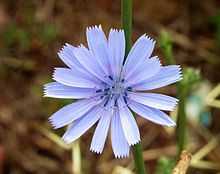Cichorium
| Cichorium | |
|---|---|
 | |
| Wild endive (Cichorium pumilum) | |
| Scientific classification | |
| Kingdom: | Plantae |
| (unranked): | Angiosperms |
| (unranked): | Eudicots |
| (unranked): | Asterids |
| Order: | Asterales |
| Family: | Asteraceae |
| Tribe: | Cichorieae |
| Genus: | Cichorium |
| Species | |
| |
Cichorium is a genus of flowering plants in the family Asteraceae. The species are commonly known as chicory or endive – there are two cultivated species, and four to six wild species.

Common chicory (Cichorium intybus) is a bushy perennial herb with blue or lavender (or, rarely, white or pink) flowers. It grows as a wild plant on roadsides in its native Europe, and in North America, where it has become naturalized. It is grown for its leaves, when it is known as leaf chicory, endive, radicchio, Belgian endive, French endive, or witloof. Other varieties are grown for their roots, which are used as a coffee substitute, similar to dandelion coffee.
True endive (Cichorium endivia) is a species grown and used as a salad green. It has a slightly bitter taste and has been attributed with herbal properties. Curly endive and the broad-leafed escarole are true endives.
Cichorium is used as a food plant by the larvae of some Lepidoptera species including Setaceous Hebrew Character, Turnip Moth, and the grass moth Diasemia reticularis.
External links
- Chicory Pollinators Diagnostic photographs; insect pollinators of chicory
- Cichorium pumilum in Wildflowers of Israel;